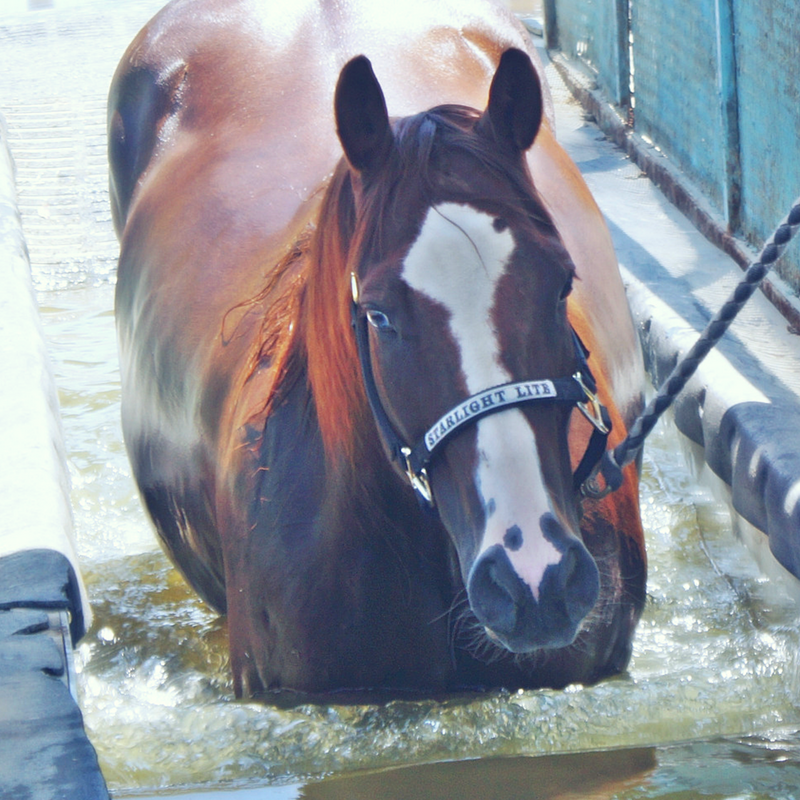Sometimes we get complacent with the most basic horsemanship skills, or sometimes we never learned the proper technique in the first place. Either way, common mistakes can lead to disaster. What are the common mistakes horsemen make tying up and leading a horse?
We’ve looked at a variety of halters and their uses, we must look at how we tie our horses up so we can groom them and tack them up. How can we learn to be better at tying up our horses so we will both be safe in a panic situation? What mistakes must we be aware of when leading a horse?
Come horse around with us in SLO County! Get your FREE Horsing Around in SLO County Hotsheet and enjoy the places to you can trail ride, stay with your horse, show your horse, and sip wine where there’s a horse connection.
What are the common mistakes horsemen make tying up and leading a horse?
Common Mistake #1: Tying a horse up to the bit
- DON’T connect the bit in a bridle to your lead rope and tie your horse up. If your horse pulls back his mouth will be injured by the bit.
- Next important step: Always use a quick release knot when tying up a horse. Horse’s need to be quickly released in a panic.

Releasing a Horse in a Panic
How many of you have had to reach over and quickly pull that quick release knot out? Your struggling horse is applying over 1,000 pounds of pressure to the lead rope, halter and knot. His splayed-out feet and shaking head are within striking distance of your extremities, body and head. Your panicked horse is NOT looking out for your best interests at the time. How do we safely untie our panicked horse? Be sure you have plenty of room to access your horse’s head BEFORE you tie your horse up.
How can we minimize the damage to ourselves, our horses and surroundings when our tied horse panics?
As always, safety first. Where we tie up our horse and how we tie are key components to the safety of our horses and us.

Where We Tie Up our Horses is Important
Common Mistake #2: Tying to something unsecured
- Your horse is big and strong so whatever he is tied to must also be big, strong and not be able to move. If your horse panics while tied to something lightweight that will move or break away under pressure, that “thing” will then chase him as he runs away from that monster “thing”.
- I knew of a situation where a young rider tied her horse to an inside stall face gate at a horse show. When her horse pulled back in a panic the face gate pulled away from the stall and then “chased” her horse all over the show grounds. It was really quite scary for the horse and those in its path.
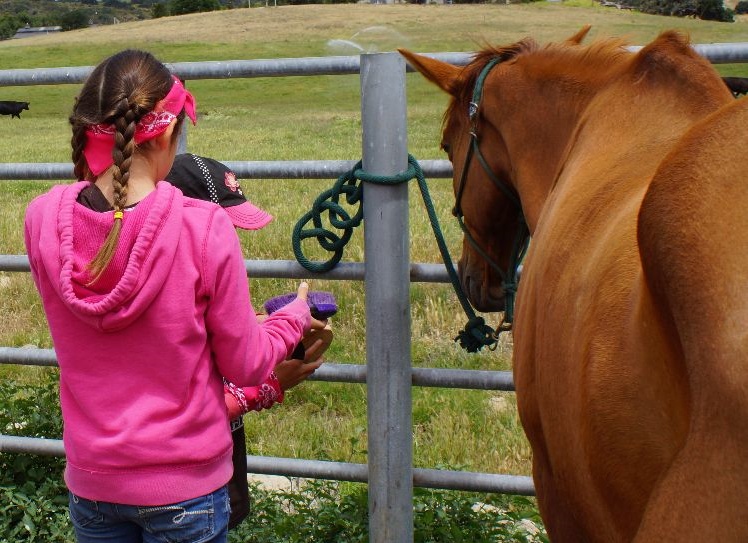
Optimal Tie Locations
Tie to the fence post NOT the fence rail: It’s really easy to quickly tie your horse to the fence rail . . . after all it’s secure isn’t it? Not at all. The fence rail, especially on a wood fence, can easily pull away from the posts and then chase a horse down the road. Always tie to the fence post, ultimately at the same height as or higher than the horse’s withers.
A hitched horse trailer: Horse trailers are big and strong but they can move, therefore the safest way to use a horse trailer to tie to is to a hitched horse trailer. Modern trailers are larger in size than the old two horse open sided trailer, but still you must use caution when you tie to an un-hitched trailer. Never leave your horse unattended when tied to an un-hitched horse trailer. Tie to the tie hooks only, not to any moving, removable or breakable part.
Common Mistake #3: Tying a horse up too low or with too long of a rope
- Tie to a horse tie rail: The optimal height for a horse tie rail is equal to the height of a horse’s withers. A tie rail must be all one piece and safely secured into the ground.
- Tying a horse up with too much free lead rope will enable the horse to get tangled up in the lead. Ideally the tie point is wither-height and the lead rope snap can just touch the ground.
Common Mistake #4: Not having an “out” for the horse handler
- No matter where you tie, you must have an out. Always position the horse so you have a way of getting out from between a horse and a solid object like a fence, a stall wall or a trailer side. Otherwise you could find yourself pinned between the horse and the unmovable object.
Be sure you have the right halter for your intended activity or purpose and get into the habit of tying your horse in a safe manner.
Now let’s look at leading a horse. What common mistakes are you allowing . . .
How To Properly Lead a Horse
Leading a horse seems pretty basic. It’s probably one of the first things we learn as we develop our horsemanship skills. Yet, many common mistakes are made leading a horse, which put us in danger. Sometimes it is a matter of just getting too comfortable.
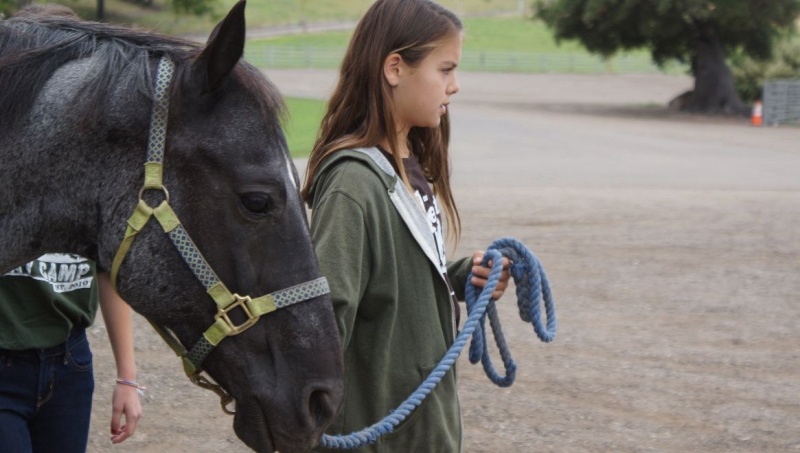
Excess Leadrope Should Be Folded in Your Hand
Common Mistake #5: The excess leadrope is circled around your hand
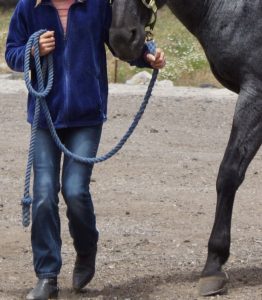
- When working with horses we must always be prepared for the worst. Leading a horse can quickly turn crazy with a burst of wind or a loud sound. Therefore how the excess lead rope is held is important.
- Instead of having it circle your hand it should be folded and held so it can easily unfold in a panic situation and not pull tight around your hand.
No Looping and Long Leadrope
Common Mistake #6: Too much lead between handler and horse
A looping and long leadrope will spell disaster in seconds as the rope will become a tripwire in no time flat if the horse decides to bolt. Always work with about an arm’s length of leadrope between you and the horse. NEVER have the leadrope around your neck or looped over your shoulders.

Lead with Eyes up and Looking Forward
Common Mistake #7: Looking at the horse and pulling him forward when leading

A horse is looking to you to be his leader at all times. Therefore when leading a horse you must look forward turning your eyes to where you want to go. Looking at your horse and pulling will simply result in a horse who does not know where to go. He will stop and pull his head up and balk.
Avoiding these common mistakes horsemen make will provide you with many more happy memories and experiences with your horse. Don’t get too comfortable and let some of these basic horsemanship mistakes creep into your practices when tying up and leading your horse.
Photo Credit: Sharon Jantzen Photos
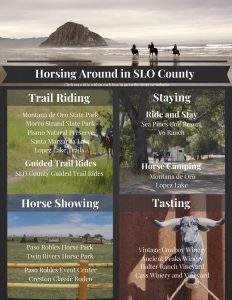
Come horse around with us in San Luis Obispo County! There are so many ways to horse around in stunning SLO County. To keep this info at your fingertips we have developed a FREE Hot Sheet that will direct you to stories which tell you where you can trail ride, stay with your horse, show and taste. We’ll continue to add horsing around stories to our website. You can stay up-to-date by becoming a SLO Horse News herd member. Get your Horsing Around in SLO County Hot Sheet here >.

